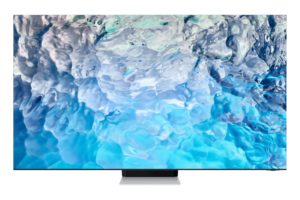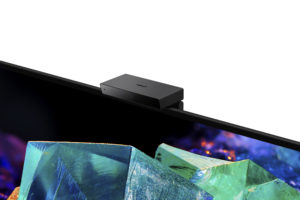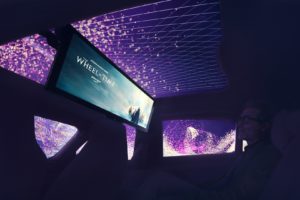The CES technology industry trade show returned to Las Vegas this January, after a pandemic-enforced hiatus in 2021. Concerns over surging Omicron virus infections led to several high profile exhibitors cancelling on-site activities, including Panasonic, Amazon, AMD and MSI, and a dramatic shortfall in attendance.
On a good year, CES will attract upwards of 200,000 trade and industry attendees, this year that figure was said to be 45,000.
Despite the challenges, there was no shortage of innovation, with next generation Mini LED TVs gaining traction, and Quantum Dot-OLED panel technology breaking cover; screen makers pivoting to offer better video game support and streaming platforms taking to the road…
CES is typically not a show where TV manufacturers reveal their ranges for the year ahead (that level of detail is usually reserved for spring trade shows), but it is a global technology showcase.
Arguably the most significant new screen development at CES 2022 was Quantum Dot OLED. QD OLED combines the recognised benefits of OLED (superior black level performance and contrast) with Quantum Dot’s class-leading colour volume and brightness.

QD Display technology is able to present 131.2 per cent of the DCI P3 colour space, compared to WOLED’s 65 per cent. For consumers, that means deeper, more authentic reds, greens and blues, without oversaturation.
QD-OLED will also enhance HDR content, as it’s able to resolve near black detail at 0.0005 nits, with HDR peaks capable of reaching 1000 nits. Extreme HDR peaks of 1500 nits are also possible, useful for depicting fireworks and similar sparkling highlights.
While Samsung Display claimed the QD Display high ground, Samsung’s consumer electronics division failed to launch any QD Display product. Instead, that fell to Sony.

Samsung is expected to announce its first QD Display models later this year, initially in 55- and 65-inch screen sizes. Samsung will also introduce a 34-inch QD-Display gaming monitor.

The new EX panel will debut in LG’s (hang-on-the-wall) Gallery screens. LG confirmed that last year’s Evo glass would be employed in its mainstream C2 TVs this year.
One clear trend for TVs in 2022 will be improved support for games consoles and PCs, with HDMI 2.1 4k 120Hz support becoming more commonplace.
Panasonic unveiled a new information and settings overlay called Game Control Board, for its 2022 TVs. The Game Control Board relates frame rate, HDR metadata and chroma sub-sampling data, while a Dark Visibility Enhancer allows the player to adjust the near black portion of dark scenes to better detect enemies in the shadows.
Panasonic’s range-topping LZ2000 flagship 4k OLED will also offer automatic NVIDIA GPU detection, improved 60Hz latency and High Frame Rate (HFR) and Variable Refresh Rate (VRR) at 120Hz in full 4k resolution.

Its latest Neo Quantum Processor boasts advanced contrast mapping, for better control of the Mini LED light source, and Shape Adaptive Light technology which allows the processor to analyse the shape and surfaces of objects, adjusting backlight intensity for better picture accuracy. Viewers should see fewer backlight blooming effects.
Also incoming is an AI picture quality algorithm, dubbed a Real Depth Enhancer, able to identify and separate individual objects from their background, to better emphasise depth.
As well as QD-OLED, Sony announced a premium 4k TV using Mini LED backlighting technology at CES. The X95K will come in 85-, 75- and 65-inch screen sizes.
TV screen size options continue to widen. LG announced an 83-inch SKU to plug the gap between its 97- and 77-inch OLED offerings; Panasonic announced a new 77-inch screen for its premium LZ2000 model, dubbing it ‘Master OLED Pro Cinema Size’ and TCL launched its 98” QLED.
More modest screen sizes are also on the cards, with 42-inch OLED models announced by both LG and Sony.
Smart home technology looks to be getting smarter in 2022. Next generation IoT platform Matter, promoted by the Connected Standards Alliance, boasted more signatories at CES, including Arlo, Comcast, and LG.
Matter is a wireless, IP-based common interoperability standard that allows compatible smart home devices to work together, regardless of brand. Matter products will run on Wi-Fi, Bluetooth LE and low power Thread mesh networks.
TVs with integrated cameras are also making a comeback. Sony unveiled Bravia Cam. This camera will be sold with some premium Sony screens in 2022, as well as packaged as an optional extra.

Chinese manufacturer TCL, known in the UK for low cost 4k TVs and smart sets powered by the Roku platform, flexed its technical muscles at CES, unveiling an 85-inch 8k Mini LED TV prototype, just 3.9mm thin. It also previewed its LEINIAO AR and NXTWEAR AIR Micro LED smart glasses.
The NXTWEAR AIR spex presents the equivalent of a 140-inch screen, as seen from a distance of 4m.
In related news, Sony announced the VR2 virtual reality headset for PlayStation 5. The new headset will offer significantly upgraded visuals, with OLED panels boasting a resolution of 2000 x 2040 pixels per eye, and 90Hz/120Hz frame rate support.
VR2 will also feature headset-based tracking, so a player’s movements are reflected in-game. As the tracking is based within the headset, there’s no longer a need to set up an external camera.
New PS VR2 Sense Technology will include headset feedback (delivering vibrations and physical effects that reflect gameplay) and 3D Audio, for deeper immersion. PS VR2 Sense controllers will also offer haptic feedback. No on sale date was given.
The UHD Alliance provided an update on its creator-sanctioned Filmmaker Mode at CES.
The preset, which disables motion smoothing and removes proprietary processing, is entering a ‘Phase 2’ development period. This will apparently include AI-powered auto adjustment settings which will monitor and compensate for ambient lighting in the viewing room.
The technique has already been used for Dolby Vision IQ and HDR10+ Adaptive. Panasonic began selling TVs with Filmmaker Mode and Intelligent sensing (which does the same job), last year.
For 2022, Panasonic will update this technology to adjust for ambient light colour temperature.
Panasonic data shows viewers perceive white differently based on ambient lighting. As most European homes use warm-coloured lights at nighttime, on-screen whites can be perceived as blueish and too cold after dusk. Its new screen will compensate for this as viewers transition from day to evening viewing.
Finally, expect streaming services to migrate from smartphones and TVs to in-car entertainment systems. At CES, Amazon partnered with BMW to show its Fire TV platform running on BMW’s new 5G 31-inch panorama (32:9 format) 8k Theatre Screen.

Amazon announced that Fire TV will be available as an option in the Jeep Wagoneer, Grand Wagoneer, and Grand Cherokee; Chrysler Pacifica, Ford Expedition, and Lincoln Navigator during 2022.



